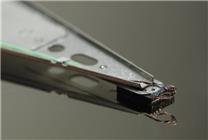Toshiba Unveils Revolutionary 12-Disc Hard Drive Set to Transform Data Storage
Summary:
- Toshiba has achieved a major milestone by developing a 12-disc hard drive, increasing the capacity limit from the previous maximum of 10 discs.
- The new 40TB hard drive is set to launch in 2027, utilizing advanced MAMR technology for higher density.
- This innovation comes in response to the surging demand for large-capacity storage driven by cloud services and generative AI.
As the data storage landscape evolves, the demand for larger capacities continues to escalate. Effective October 14, Kuai Technology highlighted a significant shift in hard drive capabilities: traditional HDDs (hard disk drives) can no longer keep pace with their SSD (solid-state drive) counterparts. One crucial limitation of current HDDs has been their maximum capacity of 10 discs. However, Toshiba is poised to change that dynamic with their groundbreaking development of a 12-disc hard drive.
According to Toshiba, the proliferation of cloud services and the rise of generative AI technologies have intensified the need for larger-capacity hard drives within data centers. Anticipating future trends, the company announced plans to release a robust 40TB hard drive in a 12-disc configuration by 2027. This innovation is expected to address the burgeoning demand for storage solutions that can support ever-expanding datasets.
Advancements in Hard Drive Technology
Historically, HDDs have been limited to a configuration of 10 discs. Toshiba’s innovation involves adding two additional discs without altering the overall dimensions of the drive. The key to achieving this has been a significant material change: transitioning from a traditional aluminum substrate to a lighter, glass-based substrate. This change not only reduces weight but also enhances performance, allowing for greater storage density.
In achieving the impressive 40TB capacity, the configuration implies that each disc would need to hold at least 3.3TB. This indicates a significant leap in storage capabilities, further emphasizing Toshiba’s commitment to innovation in the face of growing data demands.
MAMR Technology: A Step Forward
Toshiba utilizes MAMR (Microwave-Assisted Magnetic Recording) technology in the new hard drive, which allows for improved magnetic recording density. Even though this technology marks a notable advancement, it’s important to acknowledge that it may not be the final evolution in HDD technology. Current industry leaders like Seagate and Western Digital have already begun adopting HAMR (Heat-Assisted Magnetic Recording) technology. HAMR is expected to be a critical component in achieving future storage milestones, including the anticipated 100TB capacity drives.
Implications for the Future
The introduction of Toshiba’s 12-disc hard drive signals a transformative shift in the data storage industry. As data needs burgeon, primarily driven by enterprise-level cloud services and sophisticated AI applications, manufacturers are compelled to innovate rapidly. Toshiba’s commitment to providing higher capacity solutions is not just a response to market demand but a promise to enhance data management systems globally.
With the timeline set for 2027, stakeholders in the data storage sector should prepare for the forthcoming changes that Toshiba’s advancements may usher in. As the roadmap to larger capacities unfolds, it will be essential for companies to remain vigilant, adapt to emerging technologies, and leverage these innovations for improved data handling capabilities.
Conclusion
In a landscape where data storage is becoming increasingly vital, Toshiba’s announcement of its 12-disc hard drive represents a significant stride forward. As the drive industry evolves, innovations like MAMR technology will play a pivotal role in shaping the future of data storage, ensuring that businesses can meet growing demands in an efficient and reliable manner. Keep an eye on how these developments unfold in the coming years as we inch closer to a data-driven future.






